(K. Liebchen, H.-U. Hecker) Introduction The treatment of disorders of the locomotor system represents one domain of auricular acupuncture. In the case of acute disturbances, in particular, a rapid effect is to be expected; secondary phenomena are often observed which impress both the patient and the acupuncturist. As a result of the representation of the locomotor system on the anthelix, the scapha, the triangular fossa, and the superior anthelical crus on the one side and the representation of the internal organs, which can generally also be assigned to the functional circles of Traditional Chinese Medicine (TCM), in the superior and inferior conchae on the other side, both purely symptomatic treatment of complaints as well as a holistic treatment principle are possible. This usually makes sense in the case of chronic disorders. Here, however, the combination of auricular acupuncture with body acupuncture seems sensible to increase the efficacy of the treatment. In principle, the inclusion of body acupuncture in symptomatic treatment is also possible, though. In addition to neural therapy, auricular acupuncture represents a special opportunity for detecting and removing impediments to treatment, for example, in the form of disturbance fields (also called “focal disturbance,” “focus,” or “blockage”). Disturbance fields are often the cause of relapses of disorders of the locomotor system. The patient’s case history (operations, scars, uncured disorders, toxic loads) and typical skin changes in the form of scaling and reddening in the representation zone of the disturbance field often provide further assistance here in identifying these. Upon using the “very point” palpation method according to Gled itsch, disturbance fields usually reveal clearly hyperalgetic or hypersensitive areas. Treatment of these blockages via auricular acupuncture is possible. It should be pointed out that serious structural disturbances cannot be inferred from the fields of disturbance as auricular acupuncture, like all reflex methods, indicates and treats functional disturbances of the system. It is, therefore, asking too much of the method if it is expected that chronic sinusitis as a field of disturbance and a serious degenerative cervical vertebral column syndrome with development of spinal stenosis and corresponding neurological symptoms can be decisively influenced by a purely functional therapy. In the case of chronic disturbances of the locomotor system, combination with body acupuncture but also with other reflex methods such as manual therapy, neural therapy, and physical therapy presents itself as synergistic effects are frequently observable here. Differences Between French and Chinese Auricular Acupuncture Nogier’s special contribution is the discovery of the representation fields of the entire spinal column on the anthelix, starting with the cervical vertebrae on the postantitragal fossa and ending with the sacrum on the inferior anthelical crus. Chinese auricular acupuncture only recognizes maximum points of each section of the spinal column and treats all irritations of the spinal column via these. Nogier projects the lower extremities in the triangular fossa while the Chinese school locates the representation of the lower extremities on the superior anthelical crus. Chinese auricular acupuncture rather assigns the representation fields to a structural equivalent of cartilage and bone and thus puts greater emphasis on the static part, while French acupuncture focuses more on the restriction of mobility as a result of changes in ligament structures, muscles, and tendons. In practice, however, these deviations bear little relevance. In examining disturbances of the locomotor system, after a physical examination of the patient and deciding in favor of auricular acupuncture, both representation zones are examined and the most sensitive zone is then needled. Auricular Geometry According to Nogier This is based on the principle that, as a vertebrate, man is subject to segmental structuring and the extremities also only correspond to shoots from central segments. Thus, there is almost always an equivalent for all disturbances of the locomotor system in the region of the projection zones of the spinal column on the anthelix as well. This principle may also be applied to disturbances of internal organs; in this connection, reference is made to the Bladder Channel with the shu points as an analogy in body acupuncture. In his auricular geometry, Nogier establishes a treatment line between Point Zero, the irritated vertebral segment, and a responsive control point in the Vegetative Groove from which a second adjuvant line is drawn by making an imaginary angle of 30°, 60°, or 90° and responsive points are also drawn in the Vegetative Groove according to Lange or on the helical rim in the region of the projection of the spinal cord according to Nogier and Bourdiol. A parallel with manual therapy may be drawn here, in which irritations in the region of the lumbar vertebrae very often also have their correlate in the cervical vertebrae with additional segmental disturbances. Auricular geometry according to Nogier represents an important basic principle in the treatment of disturbances of the locomotor system. The Ear Relief in Cross Section (Zones I–VIII) I Zone of Organ Parenchyma II Nervous Organ Points of the Paravertebral Chain of Sympathetic Ganglia III Nervous Control Points of Endocrine Glands VI Zone of Intervertebral Disks V Vertebra Zone VI Zone of Paravertebral Muscles and Ligaments VII Vegetative Groove (Zone of Origin of Sympathetic Nuclei) VIII Projection of the Spinal Cord Nervous Organ Points of the Paraver-tebral Chain of Sympathetic Ganglia C1/C2 Location: Zone II, Superior Cervical Ganglion Point. Indication: Tinnitus, vertigo. C2/C3 Location: Zone II, Middle Cervical Ganglion Point. Indication:Functional heart problems. C7/T1 Location: Zone II, Inferior Cervical Ganglion Point, Stellate Ganglion Point. Indication:Tinnitus, pain in the chest, used for detecting fields of disturbance, migraine, obstruction of the first rib. Nervous Control Points of Endocrine Glands (According to Bahr, all the endocrine glands are gold points on the non-dominant ear.) T12/L1 (Adrenal Gland Point, Loc. 1):T6 (Adrenal Gland Point, Loc. 2) Depending on affiliation with one or the other school, different locations are indicated. Location: Zone III, Adrenal Cortex Point, Cortisone Point. Indication:Rheumatism, allergies. This point has general anti-inflammatory and analgesic activities. T12 (Pancreas Point, Loc. 1) T6 (Pancreas Point, Loc. 2) Depending on affiliation with one or the other school, different representation zones are indicated. Location: Zone III, Pancreas Point, Insulin Point. Indication:Indigestion. T4 (Thymus Gland Point, Loc. 1) T1/T2 (Thymus Gland Point, Loc. 2) Depending on affiliation with one or the other school, different representation zones are indicated. Location: Zone III, Thymus Gland Point. Indication:Allergic disorders, counteracts fields of disturbance. T5 (Mammary Gland Point) (Also partially indicated as a non-endocrine gland in this area [variation according to school]). Location: Zone III, Mammary Gland Point. Indication:Difficulties with breast-feeding, premenstrual mastodynia. C6/C7 (Thyroid Gland Point) Location: Zone III, Thyroid Gland Point. Indication:Thyroid disorders, globus sensation. C5/C6 (Parathyroid Gland Point) Location: Zone III, Parathyroid Gland Point. Indication:Bone diseases, osteoporosis, fracture healing, cramps. Projection Zones of the Bony Skeleton According to Nogier Projection Zones of the Bony Skeleton According to Chinese Nomenclature Special Clinical Pictures First of all, two basic facts must be pointed out: Before starting treatment with functional treatment methods, but no later than in the early treatment phase with primary difficulties in making a diagnosis, an orthodox medical diagnosis is imperative in order to provide causal therapy–if possible–for major illnesses in good time. Furthermore, it should be taken into consideration that auricular acupuncture of the locomotor system constitutes treatment of reflex zones and therefore the treatment of disturbances of the locomotor system may not under any circumstances be reduced to the treatment of a concrete diagnosis, for example coxarthrosis. Therefore, the point combinations discussed below may not be regarded as a general “recipe” these point combinations must also be examined for corresponding responsiveness and so individualized selection of points is always necessary. The inclusion of psychotropic points of the French school takes into account an integral right to treatment by patient and therapist as a psychogenic component is largely to be expected in many orthopedic diseases. From an orthopedic viewpoint, the following phenomenological classification of diseases of the locomotor system with the following distinctions has proved of value: Cervicogenic Pain Syndrome Afflictions of the Upper Extremities Diseases of the Locomotor System: Spinal Column Diseases of the Hip and the Lower Extremities Acute Afflictions In the treatment of the locomotor system, in the case of acute afflictions it is chiefly the ipsilateral ear which is treated at intervals of one to two days with the needles left in for between 20–30 minutes and 60 minutes. After four to five treatments, a significant reduction in complaints is to be expected; the treatment interval may then be reduced to once or twice a week. The treatment is continued until the goal set by the therapist and patient prior to treatment is achieved–usually freedom from complaints. A combination of treatments, for example, with manual medicine, often shortens the time required for healing. Chronic Afflictions In the case of chronic afflictions, a significantly extended time may be assumed. The treatment interval is therefore once or twice a week with the needles left in for 20–30 minutes. As a rule, the responsive zones of both ears are treated; no more than five to seven needles should be used per ear and session. Combination with body acupuncture has proved valuable. First the ear and then body points should be needled as auricular acupuncture reduces the responsiveness of body acupuncture points and consequently the choice of body acupuncture points necessary for actual treatment. In addition to local points in the disturbed part of the body, superordinate points are often used as well. Their selection is based on the diagnostic criteria of ba gang of TCM. As a rule, approximately 10–15 sessions are necessary for successful treatment. As there are often chronic regulatory disturbances here, relapses are to be expected and therefore the change in responsiveness obtained by acupuncture must be boosted at intervals of approx. three to six months. Nevertheless, monotherapy with acupuncture is not recommended; combined treatment involving physiotherapy and Physical Therapy as well as manual medicine, TENS (Transcutan Electric Nerve Stimulation), osteopathy, and patient guidance results in a significantly improved treatment outcome. Cervicogenic Pain Syndrome As in the lumbar vertebrae region, radicular syndromes must be distinguished from nonradicular syndromes. Although this does not matter when selecting auricular acupuncture points, it is very important when assessing the prognosis as in the case of radiculopathy with the involvement of cervical nerve roots, the structural damage is always more marked and therefore the illness can be expected to last significantly longer than is to be presumed in the case of non-radicular afflictions. Acute Disturbances In acute disturbances, there are usually more responsive zones on the ipsilateral ear; on the other hand, the contralateral ear has fewer responsive zones. As purely monosegmental illnesses tend to be rare, it may be assumed that different areas of irritability will be found on both ears. Thus, for example, disturbances in the CVZ 3 segment on the left may be associated with disturbances in the T1 segment on the right. As a basic treatment concept, auricular geometry according to Nogier is constructed on the left via the CVZ 3 segment, while on the right via the T1 segment. As the complaints are usually governed by movement, if the pain intensifies as a result of flexion/extension which according to the criteria of TCM is to be attributed to the Small Intestine/Bladder Channels (= tai yang axis), needling of the Bladder Zone (92) and Small Intestine Zone (89) is considered. If pain increases upon rotation, the Gallbladder–Pancreas Zone (96) and Liver Zone (97), which is needled here instead of the anticipated Triple Burner Zone, are tested. Nevertheless, in principle this corresponds to the shao yang axis in body acupuncture. The Triple Burner Zone has no practical relevance on the ear. Chronic Disturbances In chronic disturbances particularly on the treatment lines, if there is corresponding level localization, for the most part, sensitivities of the paravertebral ganglion points should be located and needled, as the involvement of the sympathetic nervous system is frequently observed in chronic conditions of pain in the cervical vertebrae and head region. Here the needling of psychotropic points such as the zones for Anxiety/Worry, Antiaggression and Frustration, Antidepression, and Master Omega Point in addition to the Vegetative System I and II points of vegetative harmonization and Point 55 (shen men ) also play a role in the case of corresponding associated symptoms. Cervicocephalgia In clinical terms, headaches in the dorsal region of the head which are experienced as a dull dragging sensation, rarely as a stabbing pain, are to the fore. Vegetative disturbances such as vertigo, slight nausea without vomiting, and tinnitus, which is governed by cervical vertebral column movements, are often encountered. Acute Disturbances Acute disturbances are treated with auricular geometry according to Nogier supplemented by the Occipital Bone Point (= 29 Occiput Point) and shen men (55), possibly also by points with a harmonizing effect on the vegetative system (cf. also p. 159). Chronic Disturbances In the case of chronic disturbances, in addition to auricular geometry, superordinate points of the conchae according to TCM are also included. In body acupuncture, as a longitudinal permeation of the head, points BL-2, BL-10, and BL-60 or BL-62 in addition to SI-3 and GV-14 are considered for pain in the region of the Small Intestine/Bladder (tai yang axis). In the case of pain in the radial area of the shao yang axis (Gallbladder/Triple Burner), TB- 5, TB-15, GB-20, and GB-41 are frequently needled (cf. also p. 166). Where there are indications that the temporomandibular joint is involved, this should also be included in the treatment. However, in addition to orthopedic functional therapy to eliminate faulty statics of the axis organ, in this case dental treatment must also be provided as well as, for example, in the case of bruxism, the application of relaxation techniques (autogenic training, progressive muscle relaxation according to Jacobson). Local Cervical Syndrome The complaints are purely local and appear for the most part as circumscribed muscular lumps with one-sided restriction of movement. The causes of these are segmental, reversible, functional disturbances of vertebrae which quickly respond to acupuncture. Acute Disturbances In the case of acute disturbances, as a rule a combination of auricular geometry according to Nogier with shen men (55) or the Thalamus Point (26a) are sufficient for more severe complaints. Acute torticollis or acute hyperextension injury is a special case in which manual therapy, which would otherwise be indicated, is no longer or not yet indicated. Here the Jerome Point is used in addition because of its muscle-relaxant effect. With cervical spine distortion, treatment of the Kidney Zone (95) is useful for treatment of the psychosomatic component (fright) at the same time. Other psychotropic points are also used depending on responsiveness. Chronic Disturbances Chronic disturbances appear less often as circumscribed local cervical syndrome; combinations with cervicocephalgia and cervicobrachialgia occur on a regular basis. Usually a general static/structural problem or a depressive syndrome is the underlying reason for such a disturbance. Here, in addition to auricular and body acupuncture, an in-depth investigation of the causes is indicated, in particular where there is a tendency for the complaints to relapse. Cervicobrachial Syndrome Pain projections in the arm characterize these diseases. Usually they are based on relayed pain in non-radicular incidents so that they respond well to acupuncture. In radicular incidents involving the motor system, the otherwise little used back of the auricula with its representation zones of the motor system may be included. Here too, the distinction between acute and chronic disturbance is useful. Acute Disturbances In acute disturbances, auricular geometry is primarily used in the affected area and the concept supplemented according to concomitant modalities. As obstructions of the first or second rib frequently occur at the same time, even in the case of acute disturbances sensitivity should be detected specifically in the representation zone, as this is a cause of relapse and should therefore be included in the treatment concept at an early stage. Chronic Disturbances Chronic disturbances are needled incorporating auricular geometry by means of the needling of superordinate points usually in combination with body acupuncture. When searching for sensitive vertebral motor segments, quite often these are found on several levels; here the most sensitive segment is then treated first and at the next session the sensitivities are tested again before needling. Afflictions of the Upper Extremities The treatment principle applicable here is as follows: in the case of acute illness, as a rule a local disturbance of the joint concerned may be assumed so that treatment of the joint takes precedence. On the other hand, in the case of chronic disturbances, there are regularly irritations of proximal or distal joints and the vertebral segment assigned to the affected joint. Distinction from the cervicobrachial syndrome is no longer reliable andis determined by the stage of the disease at which the patient is presented to the acupuncturist. Shoulder Joint Disturbances These subsume diseases which range from purely functional to major structural changes and are roughly summarized under scapulohumeral periarthritis. A simplesubacromial bursitis after unaccustomed physical strain can understandably be treated more successfully than a chronic impingement syndrome caused by a rotator cuff rupture. In this respect, in treating diseases of the shoulder girdle, an orthodox medical diagnosis is imperative in assessing the prospect of success of the planned acupuncture. Acute Disturbances In the case of acute disturbances, treatment is via the shoulder representation zone according to Nogier, supplemented by shen men (55) with its anti-inflammatory activity and the Jerome Point (29b) with its muscle-relaxant activity. In severe conditions of pain, the Thalamus Point is used. According to the localization of the pain, a distinction is drawn between a ventral, lateral, and dorsal shoulder pain. Ventral shoulder pain is assignable to the yang ming axis (LI–ST) or tai yin axis (LU–SP) and is treated via the reflex zones of the large intestine (90) and stomach (87) or lung (101) and of the pancreas/gallbladder (96). Clinical findings and the respective sensitivity of the reflex zones are crucial in the selection of points. In the axial diagram, lateral shoulder pain corresponds to the shao yang axis (TB–GB) and includes the Gallbladder Zone (96); the reflex zone of the Triple Burner (104) usually displays little responsiveness and is therefore seldom needled. In the case of dorsal shoulder pain, the sensitivity of the Small Intestine Zone (89) and Bladder Zone (92) is tested and if appropriate, needled in accordance with the tai yang (SI–BL) axial diagram. Chronic Disturbances Besides consideration of the treatment diagrams of acute shoulder pain, the treatment of chronic shoulder pain also requires the inclusion of auricular geometry via the frequently irritated C5 segment and body acupuncture with local and remote points. Likewise, points of emotional stabilization are also taken into consideration. Elbow Joint Disturbances Localization of the complaints is both medial (“pitcher’s elbow”) and lateral (“tennis elbow”). They are usually acute after unaccustomed use of the muscle group in the vicinity of the elbow joint. Via a muscular imbalance, this often leads via a chronic insertion tendopathy to a disturbance of muscle function chains and functional disturbances of joints. A typical example is pain on the lateral humerial epicondyle, which in the event of its becoming chronic, results in functional disturbances in the C6 segment, the acromioclavicular joint, the proximal radioulnar joint, the scaphoid, and the thumb carpometarpal joint, and therefore leads to resistance to treatment if acupuncture is restricted to purely local treatment. Acute Disturbances In the case of acute disturbances, treatment is first restricted to the representation zone of the elbow in the scapha and, depending on localization of the pain, may include the Large Intestine Zone (90) laterally or the Small Intestine Zone (89) medially. In the case of complaints governed by movement, the eminentia scaphae on the back of the ear should also be examined for sensitivities. Further selection of points isbased on the concomitant modalities of the acute disturbance: inflammation (ACTH Point), pain (shen men, 55), muscle tension (Jerome Point, 29b). Chronic Disturbances In the treatment of chronic disturbances, besides considerations regarding local needling, those regarding irritation of myofacial function chains should also be included. Therefore, disturbances in the C6 segment (auricular geometry) to the thumb carpometarpal joint play a more significant role than in an acute disturbance.
4 Diseases of the
Locomotor System
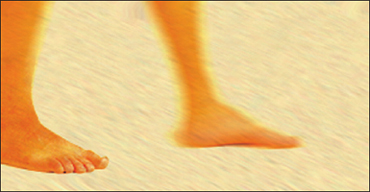
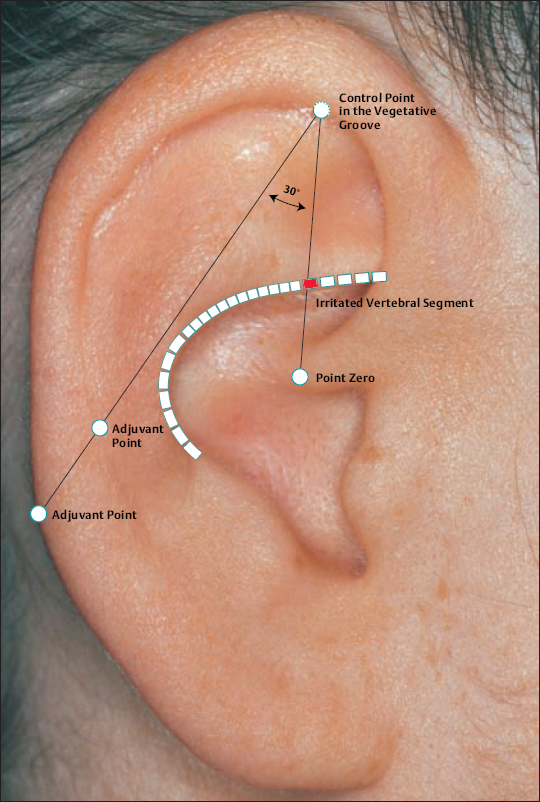
:Motor tracts
:Autonomic tracts
:Sensory tracts.

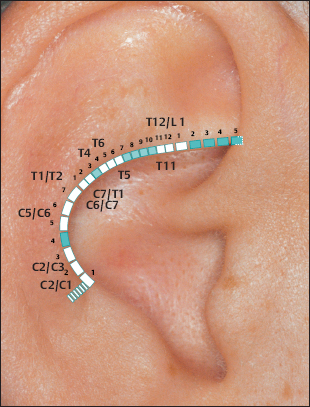

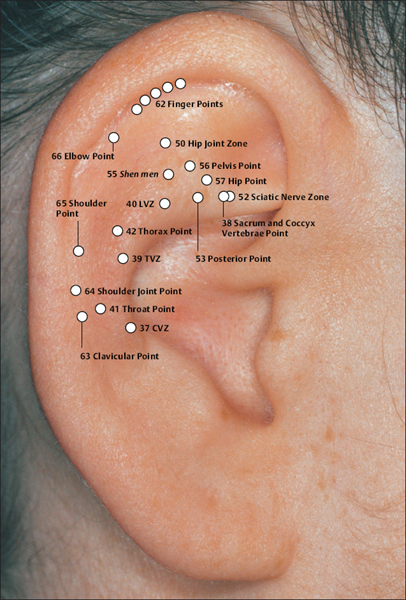

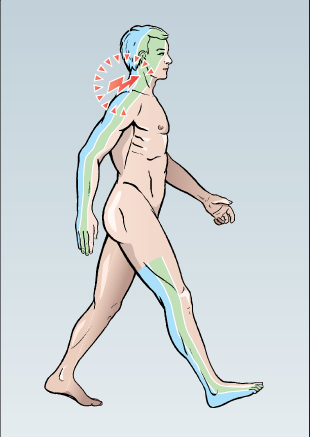
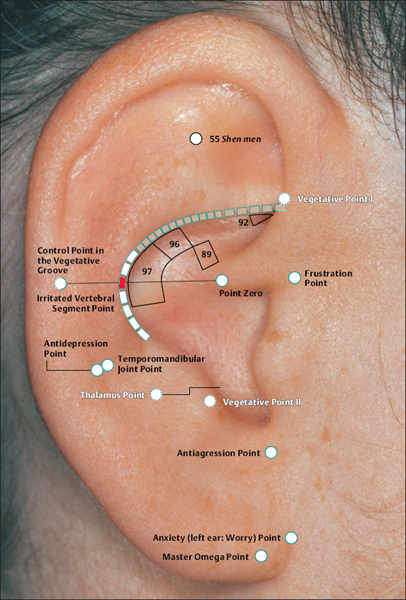
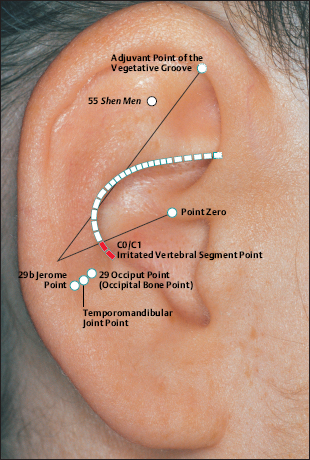
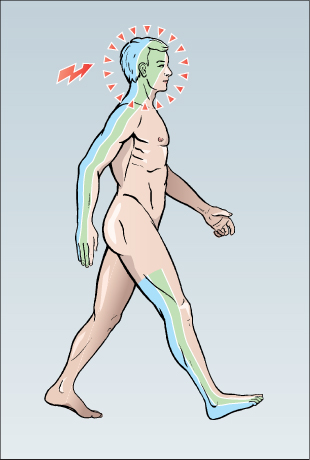
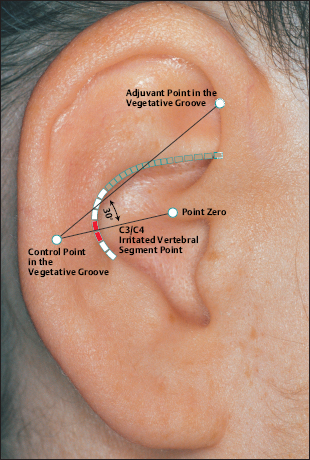
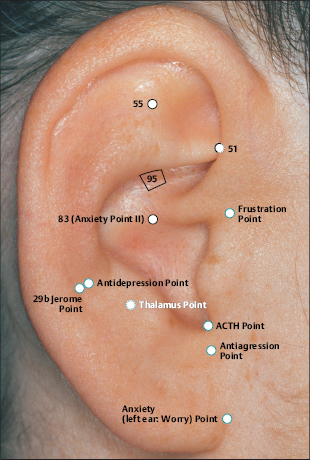
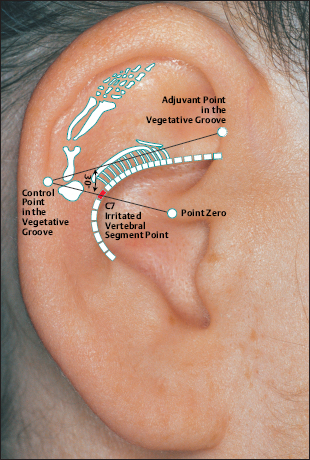
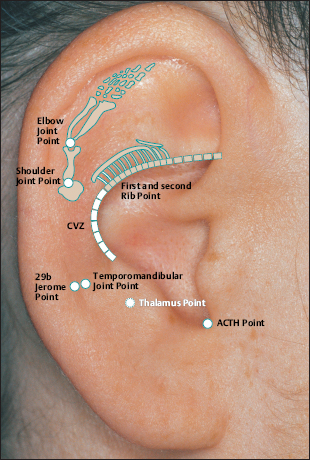
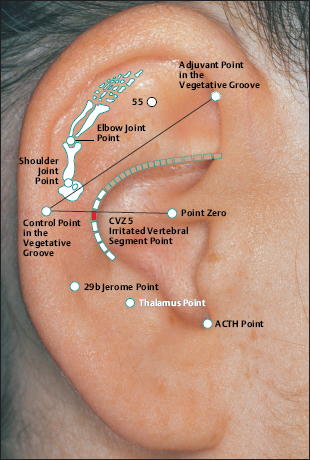
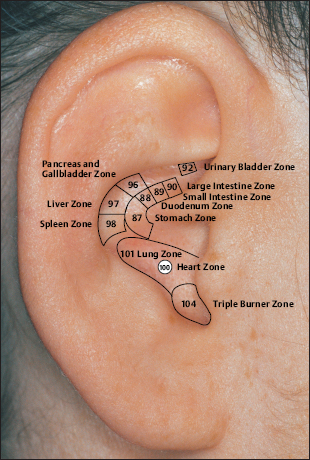
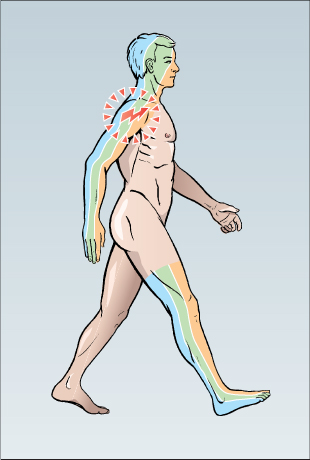

Stay updated, free articles. Join our Telegram channel

Full access? Get Clinical Tree






